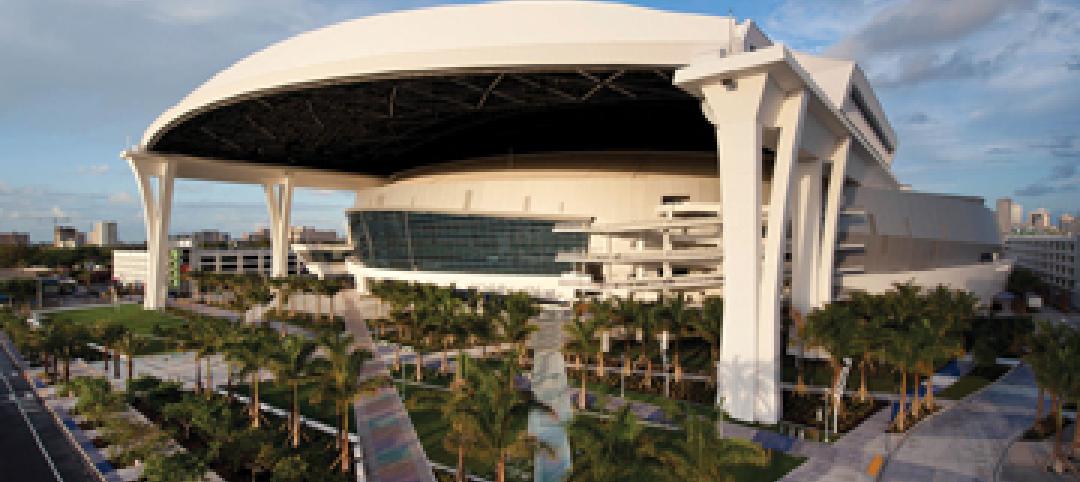As a part of the overarching project All Aboard Florida, Skidmore, Owings, and Merrill has designed a multimodal transit hub for Miami, one of three that will eventually connect Miami to Orlando by train.
The station will serve an estimated 12 million Floridians each year, and is meant to eliminate at least three million car trips each year.
The main terminal is located about 50 feet above street level. The space below will be full of retail spaces; the elevated terminal will allow for all roadside properties to remain leaseable, according to designboom.
“This project is a true celebration of the power and potential of transit-oriented development,” Roger Duffy, Design Partner at SOM, said in a press release. “We are excited to continue working with All Aboard Florida to realize this vibrant infrastructural undertaking, unparalleled in its scope, scale, and vision.”
Passenger service is expected to begin in 2016.
Here is SOM's full press release on the project:
In a ceremony today, Miami Mayor Tomás Pedro Regalado, Miami-Dade County Mayor Carlos A. Gimenez, and All Aboard Florida executives unveiled designs for All Aboard Florida’s new multimodal hub for Miami, planned and designed by Skidmore, Owings & Merrill LLP (SOM). In addition to the Miami hub, SOM is also planning and designing All Aboard Florida’s passenger stations in Fort Lauderdale and West Palm Beach, which will be unveiled at a later date.
All Aboard Florida is the only privately owned, operated and financed project of its kind being developed in the United States today. All Aboard Florida’s 235-mile network of rail lines will connect South Florida to Orlando by utilizing the current rail infrastructure for the Florida East Coast Corridor between Miami and the Space Coast and creating new tracks into Central Florida. The transformational infrastructure project will provide a vital new service for Florida residents, business people, and visitors and eliminate more than three million car trips from the region’s roadways each year. Passenger service is anticipated to begin in late 2016.
“An estimated 12 million travelers will benefit from the Miami station,” says Michael Reininger, President and Chief Development Officer, All Aboard Florida. “All Aboard Florida provides a fast and convenient transit alternative for this growing demand and need, while integrating transportation infrastructure with mixed use development to serve as a catalyst for transformation and economic vitality in a city that is quickly becoming a model for urban living today.”
“This project is a true celebration of the power and potential of transit-oriented development,” states Roger Duffy, Design Partner at SOM. “We are excited to continue working with All Aboard Florida to realize this vibrant infrastructural undertaking, unparalleled in its scope, scale, and vision.” Florida?based Zyscovich Architects is serving as the project’s Associate Architect and Planner.

renderings courtesy SOM / © SOM
SOM’s three stations will be key portals within All Aboard Florida’s rail system. Envisioned not only as gateways to their respective cities, but also as iconic destinations, the terminals will be filled with spaces to shop, eat, and meet. In downtown Miami, SOM has responded to an extraordinarily challenging and dense site by elevating the railways 50 feet in the air. Retail spaces are vertically layered beneath the soaring tracks and ample use of glass will give the station a shimmering, lightweight quality. This innovative solution allows thru-streets to remain open to traffic and for valuable streetfront real estate to remain leasable. Moreover, this bold architectural gesture creates a landmark terminal—a symbol of a 21st-century Miami.
As pieces of urban infrastructure, the stations are positioned to become centers of gravity for significant urban redevelopment. Economists estimate that All Aboard Florida will pump more than $6 billion into the Florida economy over the next eight years.
“Florida is poised to become the third largest state in the nation due to population growth,” said Kristopher Takacs, SOM Project Manager. “All Aboard Florida responds to this swelling demand by providing a fast and convenient transit alternative to the state’s highways and airport terminals. By integrating this transportation infrastructure with future mixed-use development, the terminals will be the catalysts to transform these cities locally, regionally, and globally.”
SOM has more than seven decades of experience in planning, designing, and implementing large?scale city-building projects that combine transportation infrastructure with urban mixed-use development. In the past twenty years alone, SOM has completed more than $5 billion dollars worth of transportation construction projects around the world, including complex intermodal and multimodal facilities, subway and rail stations, ferry terminals, the design of entire airports and more than a dozen airport terminals.

renderings courtesy SOM / © SOM
All Aboard Florida is an intercity passenger rail project being developed by Florida East Coast Industries, Inc. (FECI) — owner of Florida’s premier passenger rail corridor — that will connect Miami to Orlando with intermediate stations in Fort Lauderdale and West Palm Beach. This rail service will give Floridians and visitors a viable transportation alternative to congested highways and airport terminals. All Aboard Florida will provide a high?quality experience for passengers and will be the first privately owned, operated, and maintained passenger rail system in the United States. For more information, visit www.AllAboardFlorida.com.
About Florida East Coast Industries, Inc.
Florida East Coast Industries, Inc. (FECI), through its subsidiaries and affiliates, is one of Florida’s oldest and largest integrated, full?service real estate and infrastructure companies. Headquartered in Coral Gables, FL, FECI has a rich history dating back over a century when Henry Flagler first established the company which became a pioneer in the development of Florida’s eastern coast.
About Zyscovich Architects
Zyscovich Architects (Zyscovich) is an international master planning, architecture, and interior design firm with offices in Miami, West Palm Beach, Orlando, New York City, Bogotá, and Tobago. The firm's innovative approach to planning, Real Urbanism™, embraces the history and economics of a community to create a unique vision that brings tangible value and improved quality of life to the area. The firm's commitment to customized solutions is also evident in its award winning architectural design work for both public and private clients. Zyscovich's broad range of experience includes large?scale mixed?use, transportation, educational, commercial, retail, multi?family residential, and hospitality projects.
About Skidmore, Owings & Merrill LLP
Skidmore, Owings & Merrill LLP (SOM) is one of the leading architecture, interior design, engineering, and urban?planning firms in the world, with a 75?year reputation for design excellence and a portfolio that includes some of the most important architectural accomplishments of the 20th and 21st centuries. Since its inception, SOM has been a leader in the research and development of specialized technologies, new processes and innovative ideas, many of which have had a palpable and lasting impact on the design profession and the physical environment. The firm’s longstanding leadership in design and building technology has been honored with more than 1,700 awards for quality, innovation, and management. The American Institute of Architects has recognized SOM twice with its highest honor, the Architecture Firm Award—in 1962 and again in 1996. The firm maintains offices in New York, Chicago, San Francisco, Los Angeles, Washington, D.C., London, Hong Kong, Shanghai, Mumbai and Abu Dhabi.
Related Stories
| Aug 8, 2012
BD+C wins six B2B journalism awards
BD+C wins two national awards, three regional awards, and a regional Graphical Excellence award.
| Aug 8, 2012
BIM’s future up in the cloud
The AEC industry is on the cusp of a still more significant evolution with cloud computing.
| Aug 8, 2012
Giants 300 Sports Facilities Report
BD+C's Giants 300 Top 25 AEC Firms in the Sports Facilities sector.
| Aug 8, 2012
Giants 300 Science & Technology Report
BD+C's Giants 300 Top 25 AEC Firms in the Science & Technology sector.
| Aug 7, 2012
Pioneering revival
Financial setbacks didn’t stop this Building Team from transforming the country’s first women’s medical school into a new home for college students.
| Aug 7, 2012
Shedding light on the arts
Renovating Pietro Belluschi’s Juilliard School opens the once-cloistered institution to its Upper West Side community.
| Aug 7, 2012
How to win more state and local government projects
With a huge building stock at their disposal, state and local governments can be attractive clients, especially in these difficult economic times.
| Aug 7, 2012
McCarthy tops out LEED Platinum-designed UCSD Health Sciences Biomedical Research Facility
New laboratory will enable UCSD to recruit and accommodate preeminent faculty.
| Aug 7, 2012
Pankow names Lum new CEO
Lum joined Pankow in 1980 in Hawaii and has held leadership roles in Pankow’s Honolulu and Northern California regional offices and was appointed president of the firm in 2009.
| Aug 7, 2012
Suffolk Construction builds new Boston Tea Party Ships & Museum
Construction management firm links history with the future by building museum using state-of-the-art virtual models and BIM technologies.


















